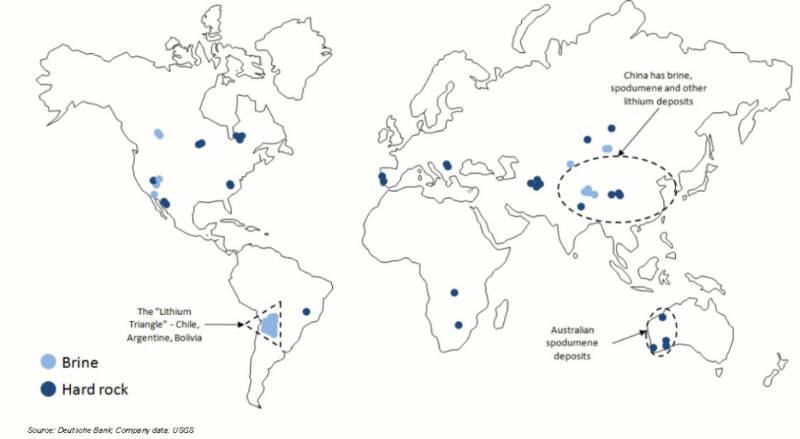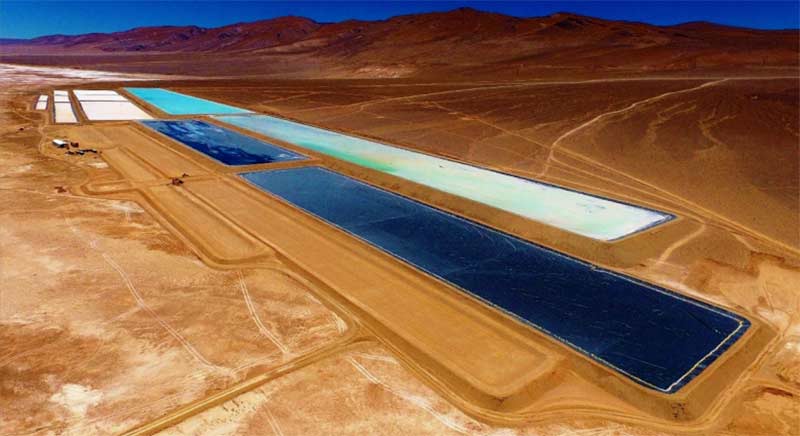School of Rock: How to Read Lithium Results

Pic: Bloomberg Creative / Bloomberg Creative Photos via Getty Images
Lithium is arguably the ‘battery metal’, given its wide use in everything from smartwatches and electric vehicles to large grid-scale battery systems.
Demand for batteries is soaring and stocks with lithium assets are hot property.
It is no surprise that exploration results put out by lithium plays are closely scrutinised for the next big company-making discovery.
But just what makes a good discovery? To understand this, we must first look at the two primary sources of lithium – hard rock and brine.

Hard rock lithium
Lithium found in hard rocks is typically part of lithium-rich minerals that are hosted in ‘pegmatites’, which are intruding rock units that form when magma intrudes into the crust.
As the magma cools, water and minerals are concentrated into metal-rich fluids that form the large crystals that define pegmatites.
These pegmatites in turn typically form thick vertical sheets that intrude into other rocks and can host ‘spodumene’ – a well-known lithium-bearing mineral.
Most of these occurrences of spodumene outcrop at surface, which Firefinch (ASX:FFX) chairman Alistair Cowden said was actually how most lithium deposits are initially found.
“There’s lots of recorded occurrences of [spodumene]. All that really has happened is that people have gone up to them, carried out sample drilling to understand how wide and what lithium grades were available,” he told Stockhead.
“Other exploration is perhaps a little more sophisticated, but like many things in lithium, we are a bit early and people have been just going to where pegmatites have been observed before.”
He added that there have not been many big lithium discoveries since the battery metal became a trend.
How to read hard rock lithium exploration results
So just what makes for good hard rock lithium exploration results?
At the very early stages, most explorers use radiometric anomalies in addition to outcrops, as some of the minerals that occur in pegmatites give off a notable signature.
“If there are associated minerals such as tin and tantalum, which are heavy minerals that often stay in the soil proximal to the mineralisation, you may do soil sampling for lithium, but most just very quickly go to drilling,” Cowen said.
As for drilling Cowden noted that grades of about 1.6% lithium oxide, which are seen at Firefinch’s world-class Goulamina project in Mali, are pretty much the “gold standard”.
“It’s really hard to see grades much higher, you do get grades up in the twos and so forth, but the average grade, if it’s less than 1%, it’s going to struggle,” he explained.
“If it’s getting closer to 1.5% then it’s pretty interesting.
“You can get grades higher than that but the issue with spodumene is that it only contains ~6% lithium oxide, so there’s not a lot of lithium in these things. Fortunately, lithium is worth a lot of money at the moment.”
Cowden added that metallurgy is very important. The cleaner the concentrate, the better the price that a spodumene producer will get from the downstream processor.
“But what’s moving very quickly is the understanding of how you float and separate the spodumene from the other minerals, and they’re continually inventing new reagents to use to optimise that process,” he noted.
“So that may become less and less of an issue as we get more and more sophisticated.”
Lithium brines

The other major source of lithium comes from saline groundwater (brines) that are enriched by dissolved lithium.
They are mostly found in Latin America – notably in the famous ‘Lithium Triangle’ in the Andes mountains where Argentina, Bolivia and Chile meet.
And the reason for this is due to a combination of factors, such as the presence of source rocks known as acid volcanics and an area where water has historically run off these acid volcanics into a landlocked lake.
“Because you actually had a lot of fault activity and uprising of the Andes Mountains, these lakes just continued to get deeper and deeper as their sides rose and the lakes just keep filing up and concentrating all the material that’s come down those rivers,” Lithium Energy (ASX:LEL) executive director Peter Smith says.
“These lakes can be 500m to 700m deep, but it’s all fill material so it’s not physically a lake anymore. It’s still a salt lake, it’s just full of mud/silt/sand.”
While brines have lower concentrations of lithium pound-for-pound compared to their hard rock counterparts, their comparative ease of extraction means that they generally have lower production costs.
Extracting brines is a matter of finding the paleochannels, and sand dominant layers. These layers are more porous and act as aquifers, which when drilled allow the brine to be pumped out, which are then pumped into evaporation ponds for concentration.
Smith notes that brines projects have multiple evaporation ponds where a certain impurities are extracted, to actually get the particular compound that you want.
This ease of production is likely why the world’s lithium carbonate production is dominated by lithium brines whereas the production of lithium hydroxide requires that the carbonate be converted – a extra step that translates into extra costs.
While lithium brine projects and their resulting products are less suitable for the production of certain battery chemistries – particularly those with high nickel content – that are favoured by European car manufacturers for better power density, longer life cycles and enhanced safety, there’s still a bright future for lithium carbonate.
Both China and Tesla have a marked preference for cheaper (yet still effective) batteries using lithium iron phosphate cathodes, which means that demand for lithium carbonate is likely to remain strong.
What makes for good results from lithium brine exploration?
Smith notes that the brines in the area that Lithium Energy is looking at can range from 500 to 600 miligrams per litre (mg/L) lithium while some companies are looking at lakes with only about 100mg/L lithium.
However he added that while starting from lower concentrations of lithium meant that the brines needed to spend a longer time in the evaporation ponds, he was not aware of any company that had got brines with 100mg/L off the ground.
“These things are always dependent on economics, the highest grade deposits are in Chile (Atacama) and are up to 1,800mg/L,” Smith told Stockhead.
“They’re probably the highest grades and if we were looking for greenfields exploration, we would probably looking at trying to get somewhere between 300mg/L to 400mg/ or better.”
ASX small cap lithium plays
Here are some small cap ASX plays with lithium projects.
European Lithium (ASX:EUR) recently completed the big Phase 2 drill program that was aimed at upgrading resources of its Wolfsberg lithium project in Austria.
While there are still assays pending from this program, initial results such as 1.9m grading 2.4% lithium oxide have highlighted that there is potential to grow the current Measured and Indicated resource from the current 6.3 million tonnes grading 1.17% lithium oxide.
The company also noted that the drill program has identified future sources of lithium-rich pegmatites at Zone 2.
Lithium Energy (ASX:LEL) is still at the early stages of exploration with work just about to start work on its flagship Solaroz project in Argentina to validate its current exploration target of between 1.5 to 8.7 million tonnes of contained lithium carbonate equivalent.
This activity will also optimise the location of drill holes that will underpin the next phase of exploration.
Galan Lithium (ASX:GLN) recently received approval to carry out a new round of drilling at its Hombre Muerto West lithium brine project in Argentina to convert high-grade resources into a maiden reserve.
Preparatory works have begun within its Pata Pila and Rana de Sal concessions, and Galan has already mobilised its drilling equipment to the site.
HMW currently hosts a resource of 2.3Mt of lithium carbonate equivalent at a grade of 946mg/li lithium, the third largest disclosed resource in the rich Hombre Muerto basin.
Lake Resources (ASX:LKE) is currently carrying out a four-hole diamond drill program at its Lake’s Kachi lithium brine project in Argentina.
Kachi currently has an inferred resource of 3.4 million tonnes of lithium carbonate equivalent and an indicated resource of 1MT LCE.
Prospect Resources (ASX:PSC) is looking for a partner to help fund and develop its Arcadia lithium mine in Zimbabwe, which currently has a resource of 72.7Mt at 1.11% lithium oxide and 119 parts per million tantalum pentoxide.
A definitive feasibility study that was updated in 2019 outlines a low-cost project with 15.5-year initial mine life with estimated pre-tax internal rate of return of 71% and payback within 18 months of first production.
Firefinch (ASX:FFX) is spinning off its Goulamina lithium project in Mali into a new joint venture with China’s Ganfeng, a leading supplier of lithium to top tier battery producers.
Ganfeng is investing US$130m in three tranches for its 50% share of the project with the last US$91m to be made upon a final investment decision (FID), which will also result in Firefinch vending its 50% interest into the new vehicle, Leo Lithium.
Goulamina is currently envisaged as producing an average of 436,000 tonnes per annum (about 64,700t of lithium carbonate equivalent) of high quality spodumene concentrate over an initial 23-year mine life.
Ore grade is expected to average about 1.6% lithium oxide in the first five years and 1.51% over the life of mine.
Over in Thailand, Pan Asia Metals’ (ASX:PAM) drilling has defined extensive pegmatite dyke-vein swarms containing lithium mineralisation associated with lithium-rich mica mineral lepidolite, which contains minerals such as tin, tantalum, caesium and rubidium that can reduce the overall cost of lithium extraction.
Assay results include 8.5m at 0.51% lithium oxide from 137.7m and 10.2m at 0.41% Li2O from 159.9m in RKDD013; 11.8m at 0.84% Li2O from 133.2m including 5.1m at 1.11% Li2O from 135.9m in RKDD014; and 18m at 0.62% Li2O from 127m including 9.3m at 0.86% Li2O from 127m in RKDD015.
Hawkstone Mining (ASX:HWK), which is changing its name to Arizona Lithium, is currently waiting on the US Bureau of Land Management approval for the drilling of 145 exploration holes and a bulk sample program at its Big Sandy project in Arizona.
Bench scale test work on lithium mineralised material from the project is ongoing with a focus on beneficiation of the ore prior to leaching.
The company has also started a strategic review of the Lordsburg lithium brine project in New Mexico, which may include geophysical surveys.
Greenwing Resources (ASX:GW1), formerly Bass Metals, recently reached an agreement to acquire Andes Litio, which holds an option agreement over the San Jorge lithium brines project that covers 36,600 hectares of ground in Argentina’s Catamarca Province.
San Jorge includes the San Francisco Salar, which covers 2,800 hectares and is partially filled by sediments eroded from older sediments on the eastern side of the salt lake.
Vulcan Energy (ASX:VUL) has appointed BNP Paribas as its financial advisor to help deliver a bankable review in the lead-up to definitive feasibility study.
The company’s Zero Carbon Lithium Project in Germany’s Upper Rhine Valley aims to produce lithium by pumping deep geothermal brines to surface, using the excess geothermal energy to power its lithium chemical process and export additional power to the grid.
Australasian Gold (ASX:A8G) has lodged a tenement application in the Mt Peake pegmatite district in Northern Territory that covers over 640sqkm next to Core Lithium’s (ASX:CXO) Anningie project.
Highly fractionated pegmatite has been mapped in the surface and documented in government reports in this region while the company is planning to start field mapping in the next few weeks.
Charger Metals (ASX:CHR) has kicked off field work at its Bynoe project near Darwin and surrounded by Core’s Finnis lithium project, which has a mineral resource inventory of 14.7Mt at 1.32% lithium oxide.
14 pegmatite anomalies have been identified within a five-kilometre zone from existing geochemistry work. Additionally, half of the tenement remains to be geochemically surveyed.
At Stockhead we tell it like it is. While European Lithium, Lithium Energy, Galan Lithium, Firefinch, Lake Resources, Prospect Resources, Pan Asia Metals and Hawkstone Mining are Stockhead advertisers, they did not sponsor this article.
Related Topics

UNLOCK INSIGHTS
Discover the untold stories of emerging ASX stocks.
Daily news and expert analysis, it's free to subscribe.
By proceeding, you confirm you understand that we handle personal information in accordance with our Privacy Policy.








